Eastern Orthodoxy in Croatia refers to adherents, religious communities, institutions and organizations of Eastern Orthodox Christianity in Croatia. It is the second-largest religious denomination in Croatia, behind the Roman Catholic Church. Over 128 000 people, forming 3.32% of the total Croatian population, are Eastern Orthodox Christians (2021).
Eastern Orthodoxy in Croatia is represented foremost by the Serbian Orthodox Church, which claims most of the Eastern Orthodox Christian faithful. Other major jurisdictions are the Bulgarian Orthodox and Macedonian Orthodox Churches. These three churches are recognized by the state.[1][2] In Croatia there are also adherents to the Montenegrin Orthodox Church. In Croatia there also exists the Croatian Orthodox Church.
Statistics

The published data from the 2021 Croatian census included a crosstab of ethnicity and religion,[3] which showed that a total of 128,395 Eastern Orthodox believers (3.32% of the total population) was divided between the following ethnic groups:
- 101,250 Serbs (78.86%)
- 15,980 Croats (12.45%)
- 2,406 Romani (1.87%)
- 1,266 Macedonians (1.47%)
- 7,493 others, undeclared or unknown (5.84%)
Serbian Orthodox Church in Croatia
This church gathers its faithful among the Serbs of Croatia. Five eparchies (dioceses) of the Serbian Orthodox Church cover the territory of Croatia:[1]
- Metropolitanate of Zagreb and Ljubljana, headed by metropolitan Porfirije Perić, since 2014.
- Eparchy of Dalmatia, headed by bishop Nikodim Kosović, since 2017.[4]
- Eparchy of Gornji Karlovac, headed by bishop Gerasim Popović, since 2004.
- Eparchy of Osječko polje and Baranja, administered by bishop Irinej Bulović of Bačka, since 2017.
- Eparchy of Slavonia, headed by bishop Jovan Ćulibrk, since 2014.[5]
Regional Council of Serbian Orthodox Church in Croatia consists of all five diocesan bishops. The council is presided by the Metropolitan of Zagreb and Ljubljana.
Major Serbian Orthodox sites include the monasteries:
- Dragović
- Gomirje
- Komogovina
- Krka
- Krupa
- Lepavina
- Sv. Lazarica
- Sv. Nedjelje
- Sv. Petke
- Sv. Vasilija Ostroškog
and the churches:
See also
- Religion in Croatia
- Croatian Orthodox Church, a World War II organization
- List of Serbian Orthodox churches in Croatia
References
- 1 2 "Ugovor između Vlade Republike Hrvatske i Srpske pravoslavne crkve u Hrvatskoj o pitanjima od zajedničkog interesa". Narodne novine - Službeni list Republike Hrvatske NN196/03 (in Croatian). Narodne novine. December 15, 2003. Retrieved February 16, 2010.
- ↑ "Ugovor između Vlade Republike Hrvatske i Bugarske pravoslavne crkve u Hrvatskoj, Hrvatske starokatoličke crkve i Makedonske pravoslavne crkve u Hrvatskoj". Narodne novine - Službeni list Republike Hrvatske NN196/03 (in Croatian). Narodne novine. December 15, 2003. Retrieved February 16, 2010.
- ↑ "Census of population, households and dwellings in 2021 – population of Republic of Croatia". Croatian Bureau of Statistics. 31 January 2023. Retrieved 8 April 2023.
- ↑ Communique of the Holy Assembly of Bishops (2017)
- ↑ Enthronement of Bishop John (Ćulibrk) of Slavonia
Sources
- Bataković, Dušan T., ed. (2005). Histoire du peuple serbe [History of the Serbian People] (in French). Lausanne: L’Age d’Homme.
- Ćirković, Sima (2004). The Serbs. Malden: Blackwell Publishing.
- Krestić, Vasilije (1997). History of the Serbs in Croatia and Slavonia 1848-1914. Belgrade: BIGZ.
- Mileusnić, Slobodan (1997). Spiritual Genocide: A survey of destroyed, damaged and desecrated churches, monasteries and other church buildings during the war 1991-1995 (1997). Belgrade: Museum of the Serbian Orthodox Church.
- Miller, Nicholas J. (1997). Between Nation and State: Serbian Politics in Croatia Before the First World War. Pittsburgh: University of Pittsburgh Press.
- Raković, Aleksandar (2013). "Short Existence of the Faculty of Eastern Orthodox Theology at the University of Zagreb 1920-1924" (PDF). Теолошки погледи. 46 (3): 951–956.


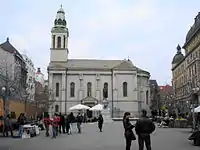
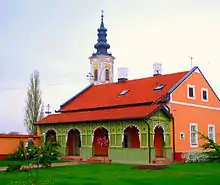
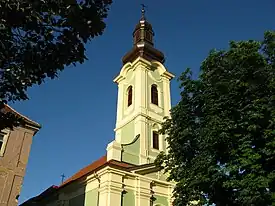
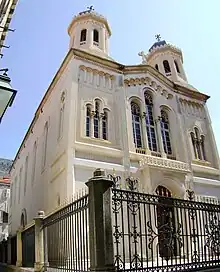
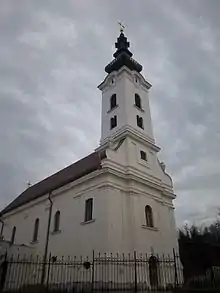
-Crkva_Silaska_Sv._duha.jpg.webp)
